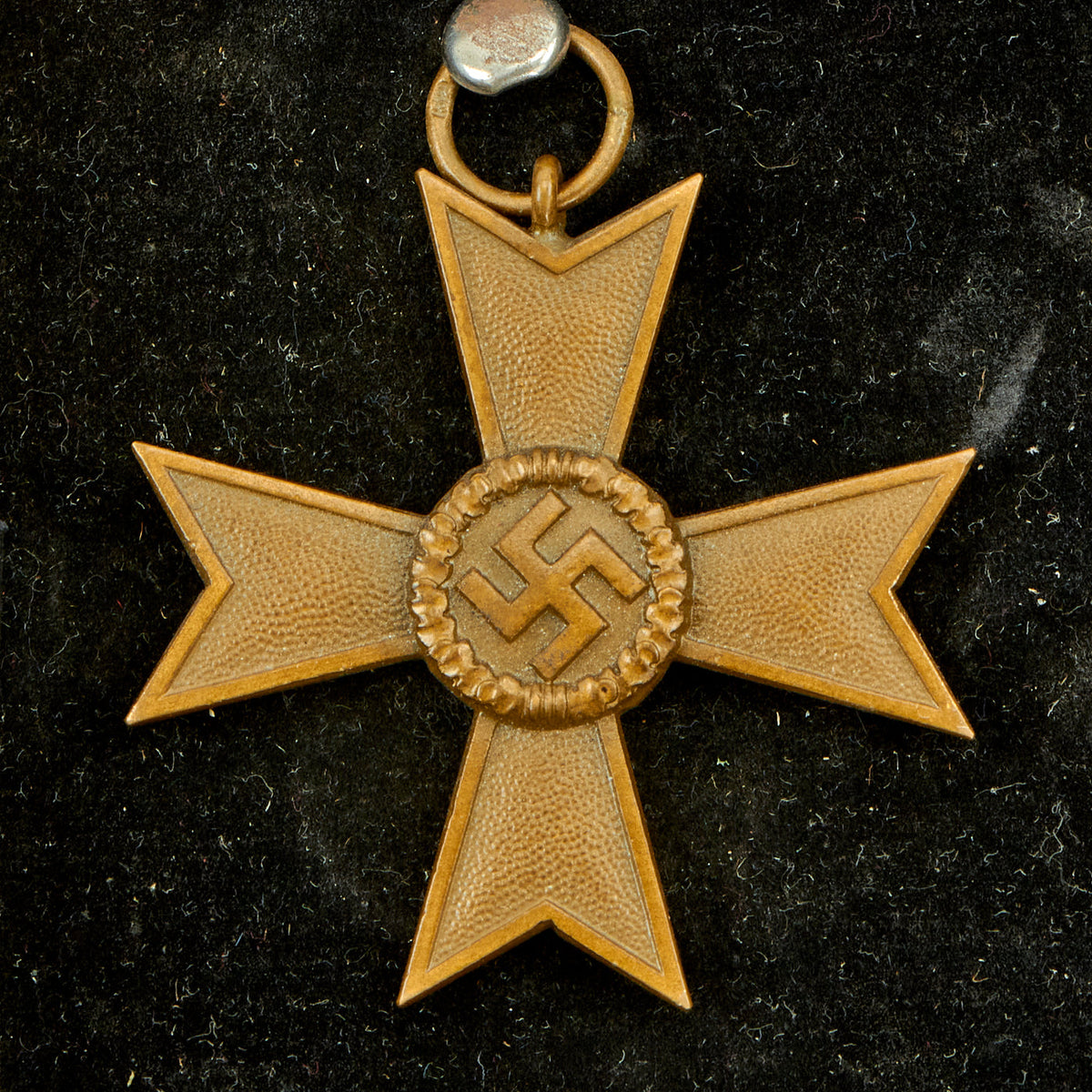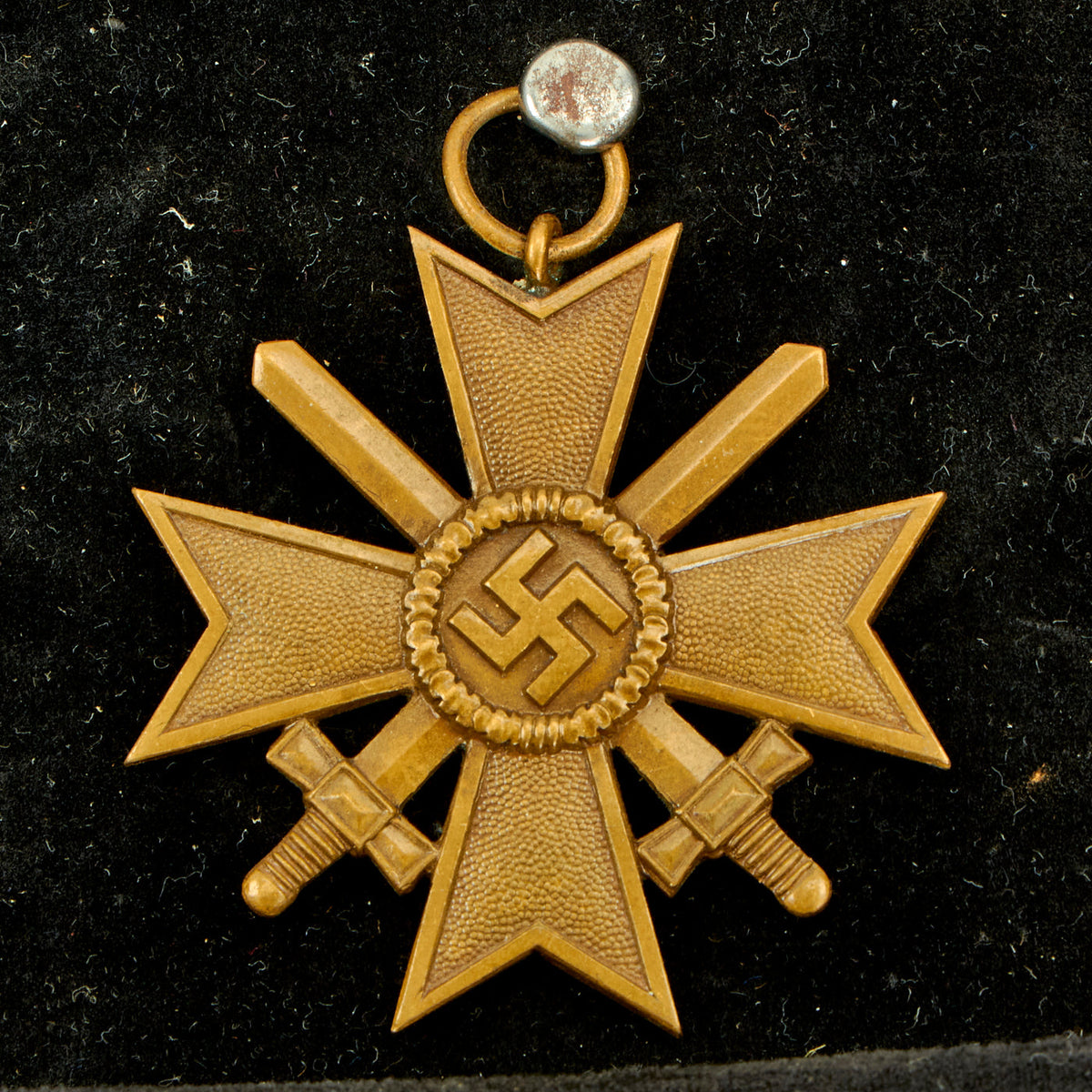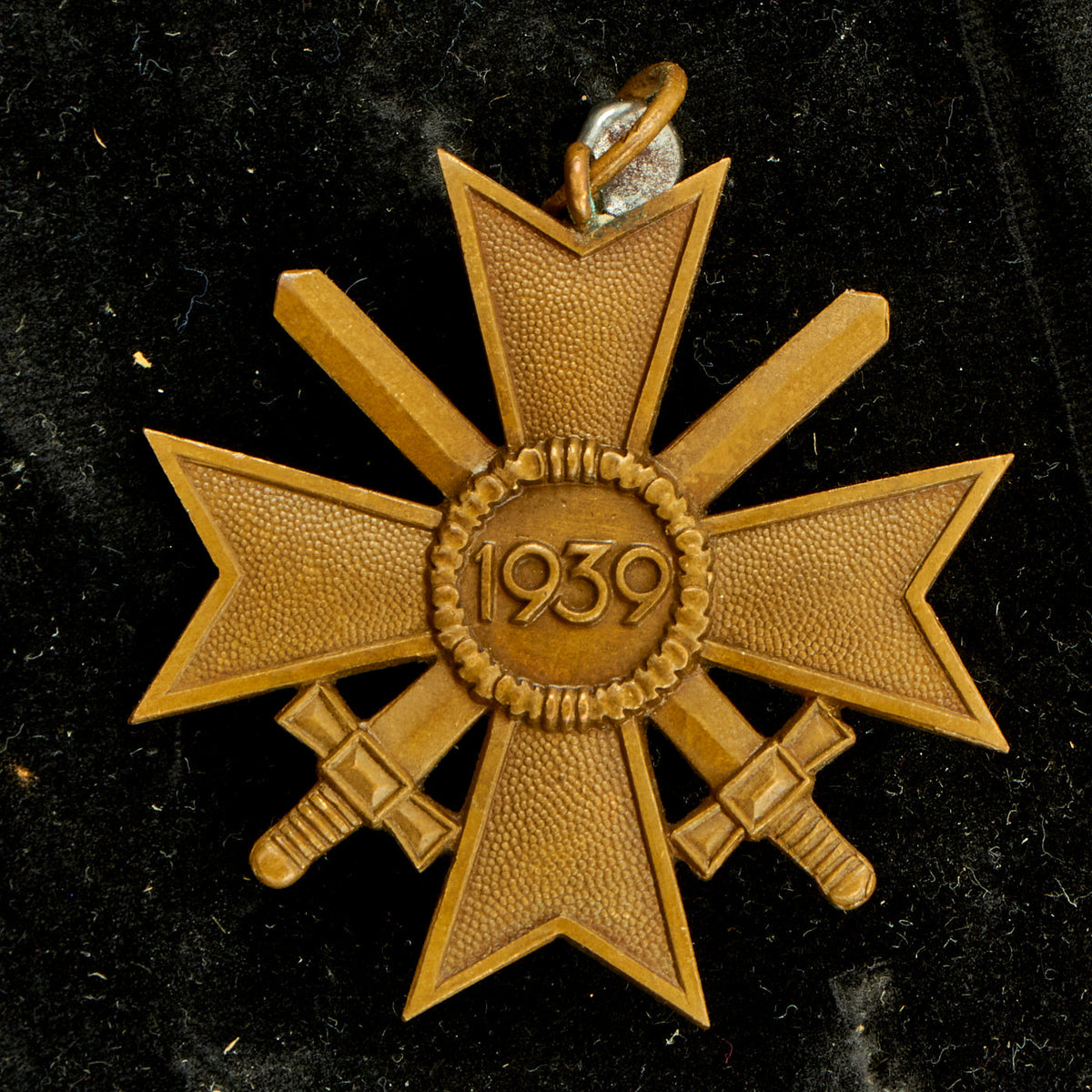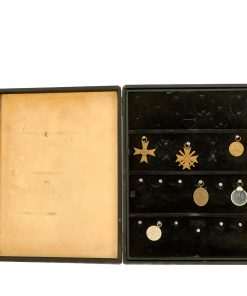Original German WWII Medal Manufacturer Advertisement Salesman’s Sample Case With 6 Original Medals Original Items
$ 495,00 $ 148,50
Original Items: Only One Available. This is a wonderful and unique example of what a German medal distributor during WWII would have been armed with. The medals of the firm you worked for would have pristine examples hanging in this case so you could advertise the craftsmanship as well as take orders from the servicemen.
The leatherette case contains 3 internal trays that would have had anything from Iron Crosses to Arm Shield and Wound Badges. The 6 medals (without ribbons) that are still contained in this case are in obvious unissued condition and are as followed:
Anschluss Commemorative Medal: The circular, highly detailed, die-struck medal was based on the 1938 Party Day Badge and designed by Professor Richard Klein. On the obverse, a man holding the flag stands on a podium bearing the eagle emblem of the Third Reich; he assists a second man onto the podium, whose right arm bears a broken shackle. This symbolizes Austria’s union with the larger Reich. On the reverse is the inscription “13. März 1938” (13 March 1938), the date of the Anschluss. The date is surrounded on the outer edge by the words, “Ein Volk, Ein Reich, Ein Führer” (“One People, One Nation, One Leader”). The medal would be suspended from a red ribbon with white-black-white stripes at the edges of the ribbon. It was made of brass or tombac bronze with a silvered matte finish.
West Wall Medal: The medal was awarded in one class. It was struck in bronze. Its oval shape featured on the obverse (from bottom to top) a bunker, a crossed sword and shovel, and the German Eagle. The reverse bore the inscription “Für Arbeit zum Schutze Deutschlands” (For Work in the Defence of Germany). Both sides of the medal were edged with a wreath of oak leaves. The medal was designed by Professor Richard Klein of Munich. The ribbon is golden brown with a white stripe towards each edge.On 10 October 1944 a second production run was authorized to reward the workers and military personnel strengthening the Siegfried line. This version of the medal was made of a bronzed zinc. A bar with the date “1944” was authorized for those who already held the 1939 version, but it was never mass-produced.
Eastern Medal: The Eastern Medal was designed by SS-Unterscharführer Ernst Krauit. Measuring 3.6 cm (1.4 in) in diameter, of (generally) zinc construction, the medal was given a gun-metal coloured coating. The concave obverse side features a national socialist eagle grasping a swas with laurel behind. The reverse features the text in capital letters: “WINTERSCHLACHT IM OSTEN 1941/42” (“Winter Battle in the East 1941-42”) featuring a crossed sword and branch below the text. A helmet and stick grenade below the medal loop as well as outer ring were finished in a polished silver effect. The medal measures approximately 44mm by 36mm.
2 x War Merit Cross KvK 2nd Class With and Without Swords: This award was created by Adolf H in October 1939 as a successor to the non-combatant Iron Cross which was used in earlier wars (similar medal but with a different ribbon). The award was graded in the same manner as the Iron Cross: War Merit Cross Second Class, War Merit Cross First Class, and Knights Cross of the War Merit Cross. The award had two variants: with swords given to soldiers for exceptional service “not in direct connection with combat”, and without swords given to civilians for meritorious service in “furtherance of the war effort”. Recipients had to have the lower grade of the award before getting the next level.
War Merit KvM Medal: The War Merit Medal (Kriegsverdienstmedaille) was a World War II German military decoration awarded to recognize outstanding service by civilians in relation to the war effort. It was instituted on 19 August 1940 and usually awarded to those workers in factories who significantly exceeded work quotas. The War Merit Medal was awarded only to Germans and non-Germans civilians, to men and women. An estimated 4.9 million medals were awarded by the end of the war in Europe. It was closely related to the War Merit Cross, which could be awarded to military personnel and civilians alike for outstanding service to the war effort.
The case is in good condition but does show wear on the corners and some cracking as well. The leatherette is mostly retained with minor areas missing pieces. Almost all of the pins for the medals are present and there is even ghosting and indentations of medals that used to be displayed in the box, if you would wish to add replacements it would be easy!
Comes more than ready for display.
Measurements: 15 ¼” x 11 ½” x 2”
Fast Shipping with Professional Packaging
Thanks to our longstanding association with UPS FedEx DHL, and other major international carriers, we are able to provide a range of shipping options. Our warehouse staff is expertly trained and will wrap your products according to our exact and precise specifications. Prior to shipping, your goods will be thoroughly examined and securely secured. We ship to thousands clients each day across multiple countries. This shows how we're dedicated to be the largest retailer on the internet. Warehouses and distribution centres can be located throughout Europe as well as the USA.
Note: Orders with more than one item will be assigned a processing date depending on the item.
Before shipping before shipping, we'll conduct a thorough inspection of the items you have ordered. Today, the majority of orders will be delivered within 48 hours. The delivery time will be between 3-7 days.
Returns
The stock is dynamic and we cannot completely manage it because multiple stakeholders are involved, including our factory and warehouse. So the actual stock may alter at any time. It's possible that you may not receive your order once the order has been made.
Our policy is valid for a period of 30 days. If you don't receive the product within 30 days, we are not able to issue a refund or an exchange.
You can only return an item if it is unused and in the same state as the day you received it. You must have the item in its original packaging.
Related products
Uncategorized
Uncategorized
Uncategorized
Uncategorized
Uncategorized
Uncategorized
Uncategorized
Uncategorized
Armored Burgonet Helmet & Polearm from Scottish Castle Leith Hall Circa 1700 Original Items
Uncategorized
Uncategorized
Uncategorized
Australian WWII Owen MK1 Machine Carbine SMG Custom Fabricated Replica with Sling Original Items
Uncategorized
Uncategorized
Uncategorized
Uncategorized
Uncategorized
Uncategorized
Band of Brothers ORIGINAL GERMAN WWII Le. F.H. 18 10.5cm ARTILLERY PIECE Original Items













































































